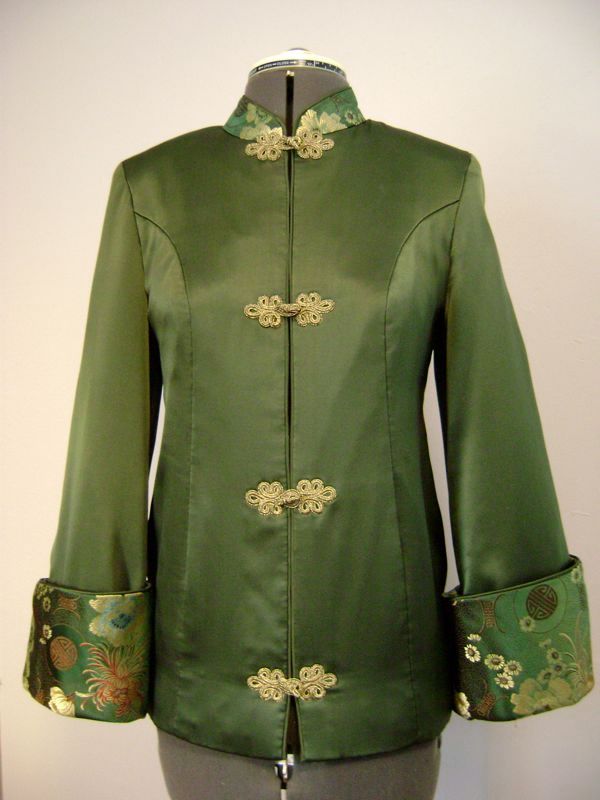
I recently got a chance to re-visit a jacket I’d made some time back for a client (we’d borrowed it in connection with an upcoming article in the magazine), and I thought a few of its details might be of interest…they were fun for me to look at again, and I’d like to share them with you.
The jacket was part of an ensemble. There was a coordinating long, slim dress made from the green silk brocade and it was all created to match the client’s emerald necklace.
The jacket is made from silk charmeuse. It’s not the ideal fabric for a shaped jacket–I’d have preferred silk satin–but it was the best I could do, color-wise, as it had to match the brocade that you see on the collar and cuffs. And with the right underlinings, it works.
The jacket, with its dramatic cuffs and gold frogs:
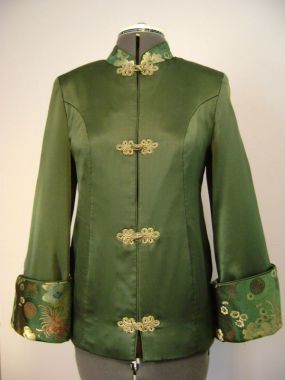
The frogs, while functional, are helped out by tiny hooks and eyes. Fairly closely spaced, the hooks and eyes keep the front edges nicely straight, with no gaping.
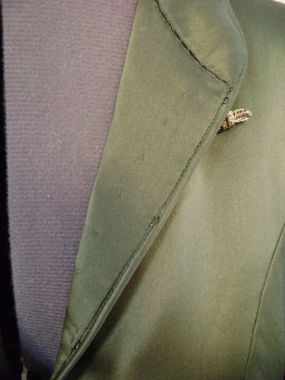
There are no front facings. Instead, the lining is hand-stitched along the inner base of the piping. It’s then understitched by hand to keep it in place; the stitches go through all the layers except the outermost.
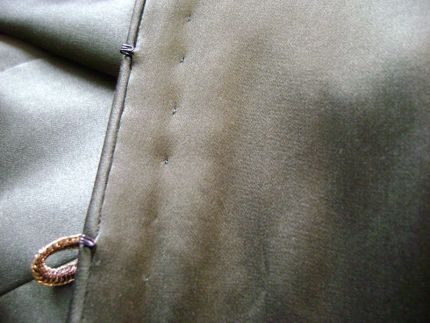
The hem is nice and firm, thanks to the jacket’s underlinings (more about those in a minute). They really help hold the shape of the jacket.
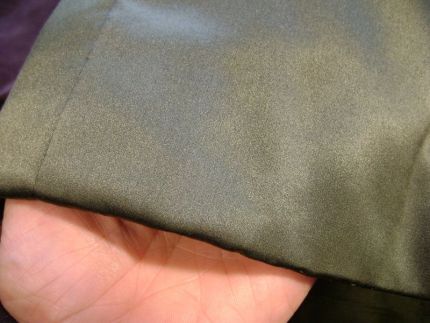
After careful alignment, the fashion fabric and the underlinings are loosely basted together just at the foldline. The thread that holds all of the layers together at the hemline is barely visible on the outside, and the hem allowance is folded so that the stitches are just out of sight.
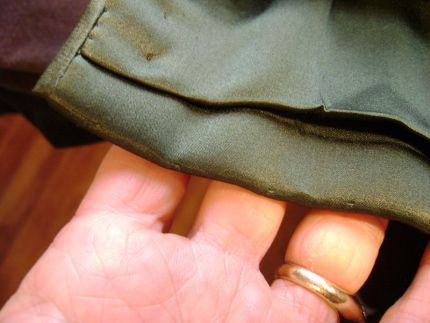
The…
Start your 14-day FREE trial to access this story.
Start your FREE trial today and get instant access to this article plus access to all Threads Insider content.
Start Your Free TrialAlready an Insider? Log in





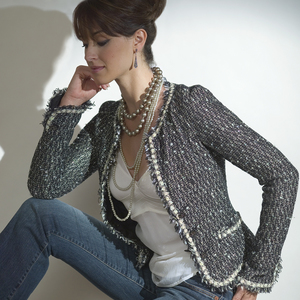
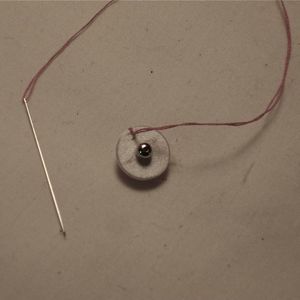
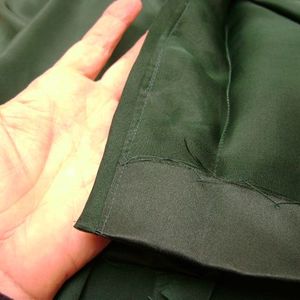


























Hi Susan, this jacket is just wonderfull!!! I would like to know how you apply the interlinings.....did you work together the charmeusse with the soft cotton flanel and the muslin like a one single fabric?? or did you work only the charmeuse with the flanel together and then shape the muslin and put it together at the armholes and borders of the jacket, or....they are all worked separetely and then put together on the armholes?? I thank you so much for your kind reply!!!
It is a gorgeous jacket. And great information and pictures. Thanks for sharing. This article was especially useful to me as I sew a lot of jackets and like to use unique and unusual fabrics, some of which are not typical jacket fabrics. Did the flannel and muslin adding bulk that needed to be considered when choosing the size of the pattern, or fitting the muslin(if there was one) or the jacket?
the jacket is beautiful.i want to make it.where did the pattern come from?
Lovely jacket-and unusual color! I am about to hand stitch the lining into my little black dress. Your hand stitching is so perfect!!!! It takes a lot of time, but I can see how much better control you have rather than running it through the sewing machine. Your jacket is an inspiration to keep stitching away!
As always, Susan's impeccable technique and skill as a teacher comes shining through! For those of you who have not had the good fortune of spending time with Susan at one of her workshops or "sit and sew" events - it is time and $ well spent. Each time I leave with stronger sewing skills and a group of amazing new sewing colleagues!
Thanks, Susan, for continuing to enrich our sewing lives!!
Best
Laura L
Washington DC
Beautiful!! My daughter has used brocade for lining a couple of coats. Doesn't show often - but you know it's there and that adds to the enjoyment.
How do you get a nice crisp hem on materials like silk charmeuse?
How do you get a nice crisp hem on materials like silk charmeuse?
What an amazing amount of detail and skill went into this. The woman who gets to wear is is lucky indeed!
Thank you all for your kind words!
Now, to answer some of those questions...
as for the pattern, I don't remember - but I think it was just a standard princess seamed jacket, and I flared the sleeves out a bit, experimenting with the muslin. Looking at it now (remember this was a few years ago), those sleeves look a little exaggerated, but, there was a whole brocade dress to balance it out, so maybe in the whole scheme of things it must have bee fine.
Nanacosta asked about the layers - and we've got an article on underlining coming up so this is timely - each garment section is treated individually, with its layers. The underlining is marked with stitching lines and the straight of grain - and then that's placed over the flannel (lining up the grain lines perfectly, pinned securely, then cut out - and then that pair of fabrics go on top of the charmeuse - again, being careful with grain lines, and then the charmeuse is cut out. So - the 3 layers work together. There's a lot of smoothing out to do, and once the layers are in order, they're hand-stitched around the perimeter. After that, the 3 layers work as one. And the extra layers don't add a huge amount of bulk - they really don't - and you can always trim the flannel out of the seam allowances; that helps a little bit. And in this case, I sort of like the padding and softness that the flannel added.
And Elsa asked about a crisp hem - underlinings help in this case - but often couture garments don't have a really sharp press on the hem. If you look closely at the hem, there was a little row of basting that held all the layers together just inside the fold line - so that helps.
Susan
Beautiful work and gorgeous jacket. MY AH-ha moment was about the hook and eyes helping with the closure. I made a jacket with the frog closure and now I will go back and add hook and eyes. This will help the problem I've had with one of the closures coming undone. Now I must go practice my hand stitching. You have inspired!
To Laurie Diane -
The nice thing about putting the lining in by hand is that you can sort of sneak those hooks and eyes in there, and pretty much cover them up. They're sewn on first, of course, then the lining goes in, with small stitches around the hooks and eyes so that the lining stays nice and flat.
They're not the easiest hooks and eyes to fasten (there's so little showing of the hook), but at least they're pretty invisible, which in this case, at least, is the more important issue.
What a beautiful jacket and an equally beautiful job you did, inside and out! I've always enjoyed hand-stitching (in several aspects, its superior to maching stitching, in my opinion) but haven't done much of it lately. That level of technique and effort is an art as well as a skill. You've convinced me to go back to my tailoring sample projects, books and class notes. I have a half-finished jacket in my stash that needs the lining added.
Very beautiful. The cuffs look a bit big, but that's just my taste. Thank you for sharing these construction details.
To Point Patou -
I agree about the cuffs - but - it's part of an outfit, and it brings up the whole idea of proportion, which is every bit as important as fit, if you ask me. So, I have to think that when the jacket was on the client, with the long brocade gown, with a person in it, maybe the cuffs didn't look quite as exaggerated as they do now! After all, you want to make a statement, and if they're just sort of normal-sized, then they don't become much of a design detail. And while the jacket is a pretty color and that collar is nice and the frogs are cute, there's not a lot going on. Enter the cuffs!
A most lovely jacket, indeed - I would have
spaced the frogs differently - so the lowest
one wasn't so close to the hem.
What a work of beauty. I plan a dress with silk charmeusse and need to find a way to work with the fabric. The last time I worked with it, I hand basted the seam and then had to use tissue paper under it sew it. Do you have any suggestions? Thank you for answering people's questions. This is the first time I've seen questions in the comments answered. You truly are a real teacher and I look forward to the day I can take a class (hopefully multiple classes) from you.
To Wendy's comment about the frog placement - well, you're sort of stuck in that one frog has to go at the fullest part of the bust, and one has to go at the base of the collar, so that sets the spacing....so the others end up where they end up.
And for Martha, about slippery charmeuse - I always use lots of pins - and patience! Normally, there's an underlining involved, and that helps stabilize things, once you get the two layers together. And of course, basting seams is pretty much required - but, it spares you the frustration of re-doing things and a poor result.
Thank you, Susan.
Hi Susan, I just want to thank you for your explanation, and I look forward for the underlining article!!! Best wishes all the way from the rain forest!!!
Susan,
I'm always looking for your articles in Threads, and the jacket is exceptional. I was going to email you, but this is so much more fun. Of course your classes, are not only the best hands on learning experience around, but you make them so much more. Thanks for sharing your knowledge and hope to see you soon for the French Jacket classes.
I would have placed those frogs in a different place. I think this jacket would look so nice modeled on the person, it is lovely, but I am sure better with the complete look. I always line things by hand, its easier than it sounds and you have a nice control over it.
I always love those kind of jackets really like it.
I would love to see the dress too, obviously. Sourcing the brocade would be my challenge. Perhaps your client brought it with her? I like the underlining process, must try that!
Thank you.
I somehow got blocked from getting the newsletter and have had to work with Taunton's tech support twice to get it started again, and how nice to have the first one be an article by you. Love the jacket, but enjoyed the details described even more. Looking forward to working with you in April.
To Belinde, about finding the brocade....as I recall, it came from Satin Moon, a small but very nice fabric store in San Francisco. Britex (also in SF) always has a good selection of those Chinese brocades, too. Just bear in mind that they're generally very narrow.